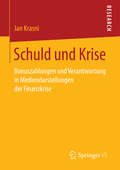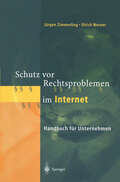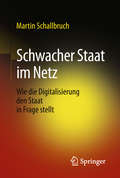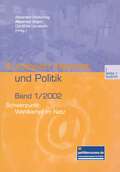- Table View
- List View
Schrödinger Operators The Quantum Mechanical Many-Body Problem: Proceedings of a Workshop Held at Aarhus, Denmark 15 May - 1 August 1991 (Lecture Notes in Physics #403)
by Erik BalslevIn these proceedings basic questions regarding n-body Schr|dinger operators are dealt with, such as asymptotic completeness of systems with long-range potentials (including Coulomb), a new proof of completeness for short-range potentials, energy asymptotics of large Coulomb systems,asymptotic neutrality of polyatomic molecules. Other contributions deal withdifferent types of problems, such as quantum stability, Schr|dinger operators on a torus and KAM theory, semiclassical theory, time delay, radiation conditions, magnetic Stark resonances, random Schr|dinger operators and stochastic spectral analysis. The volume presents the results in such detail that it could well serve as basic literature for seminar work.
Schuld und Krise: Bonuszahlungen und Verantwortung in Mediendarstellungen der Finanzkrise
by Jan KrasniJan Krasni untersucht die gängigen Antworten auf die Frage nach der ‚Schuld’ an der Finanzkrise von 2008. Er beleuchtet die Konstruktion entsprechender Erklärungs-, Argumentations- und Erinnerungsmuster aus mediensemiotischer und diskursanalytischer Perspektive. Anhand von Darstellungen ausgewählter deutscher Nachrichtenportale wird die ideologische Prägung des Finanzmarkt-Diskurses in Mainstreammedien untersucht. Der Autor kombiniert multimodale und polyphone Ansätze der Diskurslinguistik mit medienwissenschaftlichen Methoden und finanzmarktsoziologischen Einsichten. Dieser methodologische Apparat ermöglicht eine kritische Beschreibung der diskursiven und dispositiven Praxis der online-Sinnproduktion.
Schuld und Verantwortung: Otto Hahn Konflikte eines Wissenschaftlers
by Klaus HoffmannWer war Otto Hahn? Nicht sein wissenschaftliches Werk steht im Vordergrund dieser Biographie, sondern der Mensch und Wissenschaftler, der die Verantwortung für seine Forschungsergebnisse bewußt übernimmt.
SchülerInnen und Lehrpersonen in mediengestützten Lernumgebungen: Zwischen Wissensmanagement und sozialen Aushandlungsprozessen
by Melanie StadermannSchulische Kabinettprojektion: Räumliches Zeichnen im Raster (essentials)
by Berthold HeinrichBerthold Heinrich stellt die mathematischen und zeichnerischen Grundlagen für die Darstellung von Objekten im Raum auf kariertem Papier vor. Dabei präsentiert er auch die Nutzung von Software. In der Schule wird oft kariertes Papier als Raster zur Darstellung von Flächen und Körpern genutzt. Allerdings werden, selbst in einigen Druckwerken, z.B. die entstehenden Ellipsen und Winkelbögen ungenau gezeichnet oder eine Kugelkontur falsch als Kreis dargestellt. Im vorliegenden Essential werden die korrekten Verfahren sowohl theoretisch als auch an konkreten Beispielen vorgestellt und können meist direkt umgesetzt werden. Einige aufwändigere Abläufe stellt der Autor anschaulich an Beispielen dar.
Schutz genetischer, medizinischer und sozialer Daten als multidisziplinäre Aufgabe
by Heribert M. Anzinger, Kay Hamacher and Stefan KatzenbeisserFortschritte in der Medizin, in der Genomforschung und in der Informationstechnik stellen den Datenschutz vor ein Dilemma: Forschung und die Anwendung neuer Methoden setzen häufig voraus, dass personenbezogene Daten in großem Umfang zentral verfügbar, verteilbar und verknüpfbar sind. Gleichzeitig bergen zentrale Datensammlungen und die unübersehbare Weitergabe und Verknüpfung sensitiver Daten die Gefahr, dass der Einzelne auf ein Datenraster reduziert wird und Selbstbestimmungsmöglichkeiten verliert. Den Wertungskonflikten und der Schutzbedürftigkeit und Schutzfähigkeit personenbezogener genetischer, medizinischer und sozialer Daten widmete sich eine multidisziplinäre Veranstaltungsreihe des Center for Advanced Security Research Darmstadt, der Darmstädter Juristischen Gesellschaft und der Fakultät für Rechts- und Wirtschaftswissenschaften der Technischen Universität Darmstadt. Der vorliegende Band fasst die dabei entwickelten Gedanken verschiedener Wissenschaftsdisziplinen zusammen.
Schutz Kritischer Infrastrukturen im Verkehr: Security Engineering als ganzheitlicher Ansatz (essentials)
by Lars SchniederVerkehrsinfrastrukturen sind ein Rückgrat unserer Gesellschaft. Dieses essential beantwortet die Frage, was unter einer Kritischen Verkehrsinfrastruktur zu verstehen ist. IT-Systeme sind für die effektive Steuerung Kritischer Verkehrsinfrastrukturen elementar. Deshalb sind diese besonders gegen unberechtigte Zugriffe von außen zu schützen. Die Motivation zur Absicherung Kritischer Verkehrsinfrastrukturen wird aus geltenden rechtlichen Sicherheitspflichten heraus begründet. In Anlehnung an den in der Praxis seit Langem bewährten europäischen Rechtsrahmen der Produktsicherheit werden die einzelnen aufeinander bezogenen Glieder einer Qualitätssicherungskette für die Absicherung der IT-Sicherheit Kritischer Verkehrsinfrastrukturen dargestellt. Mit dem Gestaltungsparadigma der tiefgestaffelten Verteidigung (defense in depth) werden konkrete Handlungsoptionen für die organisatorische und systemtechnische Ausgestaltung des Schutzes Kritischer Verkehrsinfrastrukturen aufgezeigt.Der AutorDr.-Ing. Lars Schnieder verantwortet in einer Software-Entwicklungsfirma das Geschäftsfeld Sicherheitsbegutachtung. Er ist international als anerkannter Sachverständiger für Zugsicherungsanlagen tätig.
Schutz Kritischer Infrastrukturen im Verkehr: Security Engineering als ganzheitlicher Ansatz (essentials)
by Lars SchniederVerkehrsinfrastrukturen sind ein Rückgrat unserer Gesellschaft. IT-Systeme sind für die effektive Steuerung Kritischer Verkehrsinfrastrukturen elementar und sind gegen unberechtigte Zugriffe Dritter zu schützen. Dieses essential erläutert, was unter Kritischen Verkehrsinfrastrukturen zu verstehen ist und wie diese umfassend geschützt werden. Mit dem Gestaltungsparadigma der tiefgestaffelten Verteidigung werden konkrete Ansätze für den wirksamen Schutz Kritischer Verkehrsinfrastrukturen als Kombination technischer und organisatorischer Maßnahmen sowie Maßnahmen des physischen Zugriffssschutzes aufgezeigt.
Schutz Kritischer Infrastrukturen im Verkehr: Security Engineering als ganzheitlicher Ansatz (essentials)
by Lars SchniederVerkehrsinfrastrukturen sind ein Rückgrat unserer Gesellschaft. IT-Systeme sind für die effektive Steuerung Kritischer Verkehrsinfrastrukturen elementar und sind gegen unberechtigte Zugriffe Dritter zu schützen. Dieses essential erläutert, was unter Kritischen Verkehrsinfrastrukturen zu verstehen ist und wie diese umfassend geschützt werden. Mit dem Gestaltungsparadigma der tiefgestaffelten Verteidigung werden konkrete Ansätze für den wirksamen Schutz Kritischer Verkehrsinfrastrukturen als Kombination technischer und organisatorischer Maßnahmen sowie Maßnahmen des physischen Zugriffssschutzes aufgezeigt. Die vorliegende dritte Auflage beinhaltet eine Anpassung an den fortgeschrittenen Stand der Technik.
Schutz Kritischer Infrastrukturen im Verkehr: Security Engineering als ganzheitlicher Ansatz (essentials)
by Lars SchniederVerkehrsinfrastrukturen sind ein Rückgrat unserer Gesellschaft. IT-Systeme sind für die effektive Steuerung Kritischer Verkehrsinfrastrukturen elementar und sind gegen unberechtigte Zugriffe Dritter zu schützen. Dieses essential erläutert, was unter Kritischen Verkehrsinfrastrukturen zu verstehen ist und wie diese umfassend geschützt werden. Mit dem Gestaltungsparadigma der tiefgestaffelten Verteidigung werden konkrete Ansätze für den wirksamen Schutz Kritischer Verkehrsinfrastrukturen als Kombination technischer und organisatorischer Maßnahmen sowie Maßnahmen des physischen Zugriffssschutzes aufgezeigt. Die vorliegende vierte Auflage beinhaltet eine Anpassung an aktuelle Rechtssetzung und einen fortgeschrittenen Stand der Technik.
Schutz vor Rechtsproblemen im Internet: Handbuch für Unternehmen
by Jürgen Zimmerling Ulrich WernerDas Internet als supranationaler Raum öffentlichen Rechts ist keineswegs rechtsfrei, es stellt vielmehr das Recht vor Fragen bisher nicht gekannter Komplexität. Das Buch behandelt die wichtigsten Bereiche kommerzieller Internet-Nutzung unter dem Gesichtspunkt des deutschen Rechts und beschreibt die häufigsten rechtlichen Fallstricke. Nach einer Einführung in die Grundlagen des Cyberspace geht es schwerpunktmäßig um Domain-Namensrecht, Inhalt und Gestaltung von Webseiten, Verträge per E-Mail und HTML-Formular, Einbeziehung der Allgemeinen Geschäftsbedingungen (AGB), Werbung und Verkauf im World Wide Web sowie Datenerhebung und Marktforschung. Dabei werden insbesondere die unterschiedlichen Positionen der aktuell kontroversen Diskussion herausgearbeitet und rechtlich bewertet. Hervorzuheben ist, daß sich das Buch nicht an der juristischen Klassifikation orientiert, sondern an den praktischen Komponenten des Einsatzes von Internet-Technologien zur Marktkommunikation.
Schwacher Staat im Netz: Wie die Digitalisierung den Staat in Frage stellt
by Martin SchallbruchDie Digitalisierung fordert den Staat nicht einfach nur heraus. Sie überfordert ihn. Sie stellt in Frage, wie wir 70 Jahre lang unser Gemeinwesen gesteuert, organisiert und verteidigt haben. Unser demokratischer Staat mit seinen Institutionen und Verfahren tut sich schwer, seine bisherige Rolle auch im digitalen Raum zu spielen. Entlang persönlicher Erfahrungen zeichnet der Autor die Entstehung der Netz- und Digitalpolitik seit dem Jahr 2000 in Deutschland nach. Er beschreibt anhand von Beispielen die Mühen von Politik und Verwaltung im Umgang mit der Digitalisierung. Der Autor arbeitet die Ursachen der digitalen Schwäche des Staates heraus und präsentiert konkrete Vorschläge, wie die Politik die Wirksamkeit des Staates erhalten kann – auch in der digitalen Welt.
Schwarmintelligenz
by Heiko HamannDieses Buch veranschaulicht mithilfe mathematischer Modelle, wie man die kollektive Intelligenz natürlicher Systeme untersucht und anschließend in intelligente Algorithmen und Roboterschwärme übersetzt. Menschen nutzen Tiere seit Jahrtausenden zur Unterstützung ihrer Arbeiten und dies wird sich auch in der Zukunft nicht ändern: Anstelle der lebenden Tiere werden es jedoch ihre Intelligenzleistungen und Kommunikationsstrategien sein, die unsere modernen Leben immer mehr beeinflussen. Heiko Hamann begeistert mit seiner Faszination für die Leistungen tierischer und menschlicher Gesellschaften. In einfachen Beispielen und in eleganter, präziser und einfach verständlicher Weise erklärt er diese Systeme und ihren Inspirationsursprung.
Schwarmökonomie und Crowdfunding: Webbasierte Finanzierungssysteme im Rahmen realwirtschaftlicher Bedingungen
by Elfriede SixtCrowdsourcing steht für das Mitmachphänomen im Web 2.0. Die sogenannte Schwarmökonomie bildet sich immer dominanter in der digitalen Gesellschaft heraus. Dabei verschwindet die Grenze zwischen Produzent und Konsument – der User wird zum „Prosumenten“. Parallel entwickelt sich das Crowdfunding: viele kleine Beträge summieren sich dank webbasierter Zahlungssysteme für die Realisierung von Projekten. Als Sammelstellen agieren Online-Finanzierungsplattformen. Damit wird die Idee der sozialen Netzwerke um die ökonomische Dimension erweitert. Die Auswirkungen auf bestehende Rechts-, Steuer- und Sozialsysteme wurden jedoch bisher in der Euphorie über die neuen Möglichkeiten wenig bis gar nicht berücksichtigt. Das betrifft auch Dienstleister wie beispielsweise Paypal und Bitcoins. Das Buch informiert über die Chancen und Entwicklungen dieser neuen Finanzierungssysteme und beschäftigt sich kritisch mit ihrer Einbettung in die aktuellen realwirtschaftlichen Rahmenbedingungen.
Schwarz Methods and Multilevel Preconditioners for Boundary Element Methods
by Ernst P. Stephan Thanh TranThis book provides a comprehensive examination of preconditioners for boundary element discretisations of first-kind integral equations. Focusing on domain-decomposition-type and multilevel methods, it allows readers to gain a good understanding of the mechanisms and necessary techniques in the analysis of the preconditioners. These techniques are unique for the discretisation of first-kind integral equations since the resulting systems of linear equations are not only large and ill-conditioned, but also dense. The book showcases state-of-the-art preconditioning techniques for boundary integral equations, presenting up-to-date research. It also includes a detailed discussion of Sobolev spaces of fractional orders to familiarise readers with important mathematical tools for the analysis. Furthermore, the concise overview of adaptive BEM, hp-version BEM, and coupling of FEM-BEM provides efficient computational tools for solving practical problems with applications in science and engineering.
Schwerpunkt: Wahlkampf im Netz (Kursbuch Internet und Politik #1)
by Alexander Siedschlag Alexander Bilgeri Dorothea LamatschDas Internet nimmt für Politik und Verwaltung eine immer größere Rolle ein. Parteien und Abgeordnete bauen ihre Webpräsenz aus, die Verwaltung setzt auf E-Government und der Bürger informiert sich zunehmend auch im Internet über politische Themen. Im Kursbuch Internet und Politik schreiben Experten aus Wissenschaft, Politik und E-Business zweimal jährlich zu den Wechselbeziehungen zwischen Politik, öffentlicher Verwaltung und Internet.
Schwingungen mechanischer Antriebssysteme: Modellbildung, Berechnung, Analyse, Synthese
by Hans Dresig Alexander FidlinIn dem Buch werden systematische Methoden zur Modellbildung von Antriebssystemen dargestellt. Dies geschieht sowohl grundsätzlich für Torsions- und Biegeschwinger, aber auch speziell am Beispiel von Kränen, Rotorsystemen, Textil-, Druck-, Schneide- und Vibrationsmaschinen. Behandelt werden Schwingungsprobleme verschiedener Baugruppen wie z. B. Zahnrad-, Ketten-, Riemen-, Schubkurbel- und Schneckengetriebe. Neu in der 3. Auflage: weitere Methoden der Modellbildung und zusätzliche Beispiele zur dynamischen Analyse und Synthese von Antriebssystemen.
SCI: Architecture and Software for High-Performance Compute Clusters (Lecture Notes in Computer Science #1734)
by Hermann Hellwagner Alexander ReinefeldScalable Coherent Interface (SCI) is an innovative interconnect standard (ANSI/IEEE Std 1596-1992) addressing the high-performance computing and networking domain. This book describes in depth one specific application of SCI: its use as a high-speed interconnection network (often called a system area network, SAN) for compute clusters built from commodity workstation nodes. The editors and authors, coming from both academia and industry, have been instrumental in the SCI standardization process, the development and deployment of SCI adapter cards, switches, fully integrated clusters, and software systems, and are closely involved in various research projects on this important interconnect. This thoroughly cross-reviewed state-of-the-art survey covers the complete hardware/software spectrum of SCI clusters, from the major concepts of SCI, through SCI hardware, networking, and low-level software issues, various programming models and environments, up to tools and application experiences.
The Science and Art of Simulation I: Exploring - Understanding - Knowing
by Michael M. Resch Andreas Kaminski Petra GehringThe new book series “The Science and Art of Simulation” (SAS) addresses computer simulations as a scientific activity and engineering artistry (in the sense of a technē). The first volume is devoted to three topics: 1. The Art of Exploring Computer Simulations Philosophy began devoting attention to computer simulations at a relatively early stage. Since then, the unquestioned point of view has been that computer simulation is a new scientific method; the philosophy of simulation is therefore part of the philosophy of science. The first section of this volume discusses this implicit, unchallenged assumption by addressing, from different perspectives, the question of how to explore (and how not to explore) research on computer simulations. Scientists discuss what is still lacking or considered problematic, while philosophers draft new directions for research, and both examine the art of exploring computer simulations. 2. The Art of Understanding Computer Simulations The results of computer simulations are integrated into both political and social decisions. It is implicitly assumed that the more detailed, and consequently more realistic, a computer simulation is, the more useful it will be in decision-making. However, this idea is by no means justified. Different types of computer simulations have to be differentiated, which in turn requires the specific skill of understanding computer simulation results. The articles in this section examine the capabilities and limits of simulation results in political and social contexts, exploring the art of understanding computer simulation results. 3. The Art of Knowing through Computer Simulations? The advent of computer simulation in today’s scientific practices challenges the order of science. What kind of knowledge is gained through computer simulations is the key question in this section. Computer simulations are often compared to experiments or to arguments, and the transformation of our traditional scientific notions might be more challenging than expected – these Ideas are put forward in the third section to conceptualize the art of knowing through computer simulations.
The Science and Development of Transport—ZIRP 2021
by Marjana Petrović Luka Novačko Diana Božić Tomislav RožićThis monograph presents the original scientific manuscripts submitted for publication at the International Conference - The Science and Development of Transport (ZIRP 2021), organized by the University of Zagreb, Faculty of Transport and Traffic Sciences, Zagreb, Croatia. The Conference takes place in Šibenik, Croatia, from 30th September until 1st October 2021, aiming to bring together the scientists and the practitioners by putting forward innovative solutions available to everyone. This monograph presents the newest scientific research, case studies, and best practices in the field of transport and logistics. In addition to the main topics, many relevant manuscripts in the field of transport and logistics have been presented, such as sustainable urban mobility and logistics, safety and policy, data science, process automation, inventory forecasting, improving competitiveness in the transport and logistics services market and raising customer satisfaction. The monograph will be of interest for the experienced researchers, professionals as well as Ph.D. students in the field of transport and logistics
Science and Engineering Projects Using the Arduino and Raspberry Pi: Explore STEM Concepts with Microcomputers
by Paul Bradt David BradtHone your understanding of science and engineering concepts with the versatile Arduino microcontroller and powerful Raspberry Pi mini-computer. The simple, straightforward, fun projects in this book use the Arduino and Raspberry Pi to build systems that explore key scientific concepts and develop engineering skills. Areas explored include force/acceleration, heat transfer, light, and astronomy. You'll work with advanced tools, such as data logging, advanced design, manufacturing, and assembly techniques that will take you beyond practical application of the projects you'll be creating. Technology is ever evolving and changing. This book goes beyond simple how-tos to teach you the concepts behind these projects and sciences. You'll gain the skills to observe and adapt to changes in technology as you work through fun and easy projects that explore fundamental concepts of engineering and science. What You'll LearnMeasure the acceleration of a car you're riding inSimulate zero gravityCalculate the heat transfer in and out of your housePhotography the moon and planetsWho This Book Is ForHobbyists, students, and instructors interested in practical applications and methods to measure and learn about the physical world using inexpensive Maker technologies.
Science and Global Challenges of the 21st Century – Innovations and Technologies in Interdisciplinary Applications (Lecture Notes in Networks and Systems #622)
by Ekaterina Isaeva Álvaro RochaThis book comprises proceedings of the 2022 International Forum “Science and Global Challenges of the XXI Century”. The main principle of the Forum’s program is interdisciplinarity, the formation of end-to-end innovation chains: fundamental and applied research, technology development, implementation, and wide application of networks and systems. In 2022, the central theme of the forum is innovations and technologies in interdisciplinary applications. The book covers a wide range of knowledge-communication methodologies and effective technologies for processing data in various forms and areas. The book might interest researchers working at the interface of disciplines, such as e-learning, digital humanities, computational linguistics, cognitive studies, GIS, digital geography, machine learning, and others. It can also be a valuable source of information for Bachelor and Master students with open curricula or majors and minors who seek to find a balance between several fields of their interest.
Science and Global Challenges of the 21st Century - Science and Technology: Proceedings of the International Perm Forum “Science and Global Challenges of the 21st Century” (Lecture Notes in Networks and Systems #342)
by Alvaro Rocha Ekaterina IsaevaThis book comprises the proceedings of the International Perm Forum “Science and Global Challenges of the 21st Century” held on October 18th – 23rd, 2021, at Perm State University, Perm, Russia. Global challenges, which determine the main trends in the development of social and economic life in the XXI century, require the integration of specialists in various fields of knowledge. That is why the main principle of this edition is interdisciplinarity, the formation of end-to-end innovation chains, including fundamental and applied research, and the wide application of smart innovations, networks, and information technologies. The authors seek to find synergy between technologies and such fields as computer science, geosciences, biology, linguistics, social studies, historical studies, and economics. The book is of interest to researchers seeking nontrivial solutions at the interface of sciences, digital humanities, computational linguistics, cognitive studies, machine learning, and others.
Science and Technologies for Smart Cities: 7th EAI International Conference, SmartCity360°, Virtual Event, December 2-4, 2021, Proceedings (Lecture Notes of the Institute for Computer Sciences, Social Informatics and Telecommunications Engineering #442)
by Sara Paiva Xuejun Li Sérgio Ivan Lopes Nishu Gupta Danda B. Rawat Asma Patel Hamid Reza KarimiThis book constitutes the refereed proceedings of the 7th Annual SmartCity360° Summit which was organized in November 2021 in Porto, Portugal. Due to COVID-19 pandemic the conference was held virtually. The volume combines selected papers of 6 conferences, namely EdgeIoT 2021 - International Conference on Intelligent Edge Processing in the IoT Era; IC4S 2021 - International Conference on Cognitive Computing and Cyber Physical Systems; SmartGov 2021 - International Conference on Smart Governance for Sustainable Smart Cities; SmartGift 2021 - International Conference on Smart Grid and Innovative Frontiers in Telecommunications; e PFSM 2021 - International Conference on Privacy and Forensics in Smart Mobility. The 45 full papers were carefully selected from 109 submissions. The papers are organized in four thematic sections on Smart Grid and Innovative Frontiers in Telecommunications; Smart Governance for Sustainable Smart Cities; Privacy and Forensics in Smart Mobility; and Sensor Systems and Software.
Science and Technologies for Smart Cities: 6th EAI International Conference, SmartCity360°, Virtual Event, December 2-4, 2020, Proceedings (Lecture Notes of the Institute for Computer Sciences, Social Informatics and Telecommunications Engineering #372)
by Sara Paiva Sérgio Ivan Lopes Rafik Zitouni Nishu Gupta Sérgio F. Lopes Takuro YonezawaThis book constitutes the refereed proceedings of the 6th Annual Smart City 360° Summit. Due to COVID-19 pandemic the conference was held virtually. The volume combines selected papers of seven conferences, namely AISCOVID 2020 - International Conference on AI-assisted Solutions for COVID-19 and Biomedical Applications in Smart-Cities; EdgeIoT 2020 - International Conference on Intelligent Edge Processing in the IoT Era; IC4S 2020 - International Conference on Cognitive Computing and Cyber Physical Systems; CiCom 2020 - International Conference on Computational Intelligence and Communications; S-Cube 2020 - International Conference on Sensor Systems and Software; SmartGov 2020 - International Conference on Smart Governance for Sustainable Smart Cities; and finnally, the Urb-IOT 2020 -International Conference on IoT in Urban Space.
























